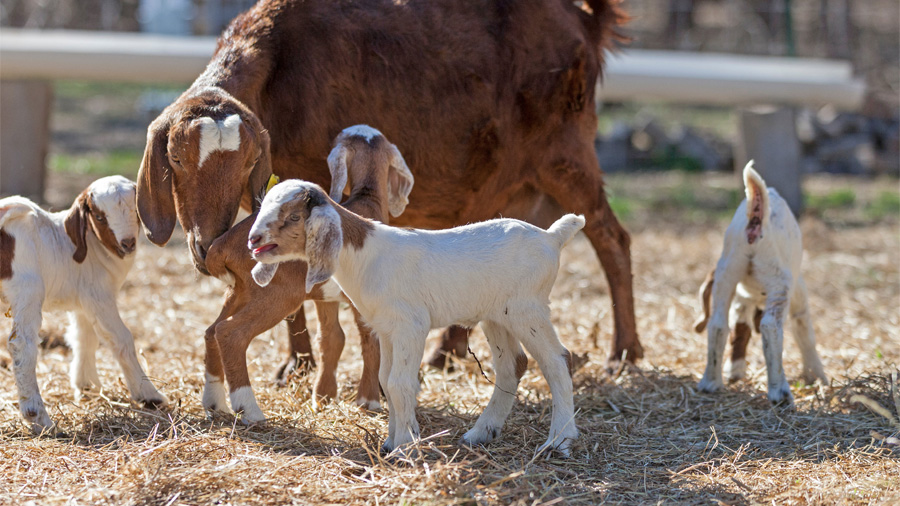We have all seen animals that we wish had come in about three months earlier! How do we encourage clients to castrate early? Why are we castrating at all?
For many of our livestock species, meat taint is not a significant problem. Many ethnic meat markets now prefer intact males.
Since testes in livestock are descended at birth, early castration reduces the animal’s pain and distress and its recovery time. As the animals get larger, the risk for complications like hemorrhage, chronic pain, and scirrhous cord increases.
The research looking at technique for castration and measurable effects on production is equivocal. However, a growing public/consumer concern for animal welfare is driving many to rethink traditional farm practices.
Castration for Calves
The American Association of Bovine Practitioners (AABP) guidelines (1) are to castrate calves within the first 24 hours of life up to three months of age. The guidelines also encourage the use of local anesthetic for testicular blocks or spermatic cord blocks to minimize pain associated with castration. Local anesthetic effectively blocks the pain-induced cortisol response for the first 30 to 90 minutes after administration.
Local anesthetic should be given with human and animal safety in mind. The use of lidocaine impregnated bands have been shown to provide therapeutic levels of lidocaine from two hours up to 42 days. They are labeled for calves up to 250 lbs and lambs up to 50 lbs.
Non-steroidal anti-inflammatory drugs (NSAIDs) can mitigate post-procedural pain. In the USA we have no drugs labelled for use for control of pain post-castration. Thus, a veterinarian-client-patient relationship (VCPR) is necessary to prescribe extra-label drug use.
Meloxicam has been shown to mitigate post-procedural pain for up to 48 hours after a single dose in calves and improves average daily gain in castrated calves. Repeat dosage is recommended when castration is delayed beyond three months of age.
Castration for Sheep and Goats
In sheep and goats that will remain as pets or fiber animals, castration may be delayed to reduce the risk of urolithiasis. Waiting until the animals are closer to sexual maturity (six to eight months old) allows for increased urethral diameter.
Current American Association of Small Ruminant Practitioners (AASRP) guidelines (2) include the following:
- Banding without the use of local anesthetics should only be performed under seven days of age, but after the maternal bond has been established and colostrum intake achieved (e.g., at 24 hours old).
- Banding can be performed older than seven days of age and up to 12 weeks of age, but local anesthetics and/or NSAIDs should be used.
- Surgical castration can be performed at any age, but anesthesia and analgesia should be used if performed after seven days of age.
- Castration in animals older than 12 weeks of age should be performed by a veterinarian using appropriate anesthesia and analgesia.
- Infection following surgical castration can be minimized by not performing the procedure in muddy or dusty environments, wet or humid weather, or during periods of high fly activity. Burdizzo (clamping) is a suitable alternative for these environments, but this method of castration may be less effective. Prior to surgical castration, animals should receive tetanus vaccination to minimize the risk of infection.
- Injection of local anesthetic into the spermatic cords and/or testes is recommended prior to surgical castration. NSAIDs acceptable for extra-label use (e.g., flunixin meglumine, meloxicam) are recommended following surgical castration.
Castration for Pigs
The American Association of Swine Veterinarians recommends that surgical castration in pigs should be performed as soon as reasonably possible after birth and sufficiently prior to weaning such that no open wounds remain at the time of weaning. Clean, sharp equipment must be used to minimize pain and risk of infection. If surgical castration is performed after weaning, analgesia and/or anesthetic protocols permissible under the Animal Medicinal Drug Use Clarification Act of 1994 (AMDUCA) should be used.
Promoting Animal Welfare
Public attitudes and expectations are changing. We are often met with resistance when implementing changes to farm protocols. If we educate our clients on current animal welfare recommendations, we can improve the well-being of animals under our care.
By Tessa Marshall, BVSc, MS, DABVP (Dairy Practice)
References




